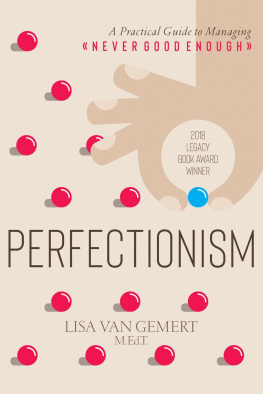A Fawcett Book
Published by The Random House Publishing Group
Copyright 1992 by Allan E. Mallinger and Jeannette De Wyze
All rights reserved.
Published in the United States by Fawcett Books, an imprint of The Random House Publishing Group, a division of Random House, Inc., New York, and simultaneously in Canada by Random House of Canada Limited, Toronto.
Fawcett is a registered trademark and the Fawcett colophon is a trademark of Random House, Inc.
www.ballantinebooks.com
This edition published by arrangement with Clarkson N. Potter, Inc.
Grateful acknowledgment is made to the following for permission to reprint previously published material:
Alfred A. Knopf, Inc.: an excerpt from The Accidental Tourist by Anne Tyler. Copyright 1985 by Anne Tyler Moldarressi.
Bantam Books: an excerpt from Journey of Awakening by Ram Dass.
Crown Publishers, Inc.: an excerpt from Taking the Manly Way Out from Dave Barry Talks Back by Dave Barry. Copyright 1991 by Dave Barry.
E P Dutton: an excerpt from The Boy Who Couldnt Stop Washing by Judith L. Rapoport.
HarperCollins Publishers: an excerpt from The Addictive Organization by Anne W. Schaef and Dianne Fassel; an excerpt from You Cant Go Home Again by Thomas Wolfe.
Library of Congress Catalog Card Number: 92-97328
eISBN: 978-0-307-79862-6
v3.1_r1
For Murphy, Jesse, Noah, and Ben
A.E.M .
For Steve, Michael, Elliot,
and The Cosmic Scorekeeper,
wherever he/she lurks
J.D .
ACKNOWLEDGMENTS
The ideas in this book are a distillate of my own observations and the writings and teachings of many others.
All therapists are deeply indebted to Freud for his now classic descriptions of both the obsessive personality and the obsessive compulsive disorder, as well as literally dozens of seminal and revolutionary concepts that are now automatic components of every psychiatrists training.
Recent theorists such as Harry Stack Sullivan, David Shapiro, and Leon Salzman greatly enriched our understanding of the obsessive personality style. Sullivan described how obsessiveness is a logical result of an anxious childs attempt to gain a sense of security within the family. Shapiro pioneered the theory that obsessiveness is much more than a set of defenses and adaptions; its a style of beingof thinking, of speaking, of handling feelings and relationships.
Salzman advanced our understanding still further. He delineated the core dynamic central to the obsessive style: namely, the illusory attempt to deal with anxiety engendered by the perception of ones own vulnerability in a universe filled with risks.
I am also indebted to the cognitive theoristsBeck, Bieber, Ellisfor clarifying the central role of irrational beliefs and assumptions that underlie and perpetuate dysfunctional behavior, and for offering us therapeutic tools to deal with these distortions.
I particularly want to acknowledge the late Irving Bieber, M.D., beloved mentor and friend, for his patient guidance and support, and his vigorous encouragement to write, even when I was a rebellious psychiatric resident. I only hope that I am passing on to my own residents, patients, and readers some small reflection of his wisdom and humanity.
I am also grateful to friends and colleagues who took the time to read and critique drafts of the manuscript, especially: Victoria Brown, Maureen Gevirtz, Paula Kriner, Paul Krueger, Nan Van Gelder, and Stephen Wolfe.
The following people made helpful comments and suggestions: Paul Koprowski, Judith Liu, Ellen Margolis, Kathleen Murphy Mallinger, Irving Osowsky, and Sandra Sveine.
Allan E. Mallinger, M.D.
CONTENTS
AUTHORS NOTE
Throughout the book, I use many case studies to illustrate various aspects of obsessiveness (disguised, of course, to protect my patients identities). Often the person described is actually a composite of several patients with similar psychological characteristics.
Many of these clinical vignettes include exchanges drawn verbatim from tapes or from notes I took during sessions. Some have been edited for clarification. But most of the quotes represent exactly what was said, given the limitations of note-taking.
Introduction
I n my twenty years of practice, I have always found my obsessive patients to be among the most intriguing. And early on, it became clear to me that many laypeople also wanted to know more about obsessiveness. When I lectured about personality styles before adult-education classes, most of the questions I was asked seemed to be about the obsessive personality. Soon I began receiving invitations to talk about that topic alone, and there were seldom empty seats; in fact, overflow audiences stood at the back of the hall. Often my listeners would respond in ways that suggested they were all too familiar with the various obsessive traits I was describing.
Before professional audiences, too, I detected an avid interest in the subject. In after-class discussions with psychiatric residents and other mental-health professionals, I learned that many of these therapists were finding their obsessive patients particularly challenging and, in some cases, downright frustrating to work with. Obsessive people often are controlling or cerebral or distrustful or secretive or emotionally constricted or resistant to change or all of the above, any one of which can make therapy difficult. I found my colleagues to be hungry for any ideas that might help them.
This prompted my decision to expand my lecture notes into a monograph for therapists, discussing the basic dynamics of the obsessive personality and pointing out potential pitfalls in working with obsessive patients. When I showed a summary of my proposed monograph to friends, several claimed that they recognized their own personalities in my accounts, and said they had experienced, or were currently having, many of the same difficulties as the patients I described. Their comments inspired me to change the focus of my project, and to write directly to the obsessive person and to people in relationships with obsessives.
That decision presented me with a particular challenge in regard to giving advice. When I practice face-to-face therapy with my patients, I become very familiar with their psychological makeup. The intimate connections between us guide me in what I say and what I avoid saying; what will help and what may do more harm than good. And when I do say something, I receive continual feedback, both verbal and nonverbal, as to how my patient is reacting. My reading of this feedback enables me to decide what to say or do next, or whether to be silent. When my patient is a reader, however, I have none of this information.
I also believe that specific advice as the avenue to change is overrated. Even in face-to-face therapy, when Ive done very brief, direct, concrete interventions (e.g., Go home and do these three things), and have later asked much-improved patients what aspect of our work helped the most, they often say such things as I felt that you cared about me; You seemed optimistic that I would get better; You didnt seem to be judging me; When I understood what was causing my behavior, I was able to change it. Only when I ask specifically, But what about the techniques that I taught you and the homework you did? do they respond, Oh, yes. That helped too.














